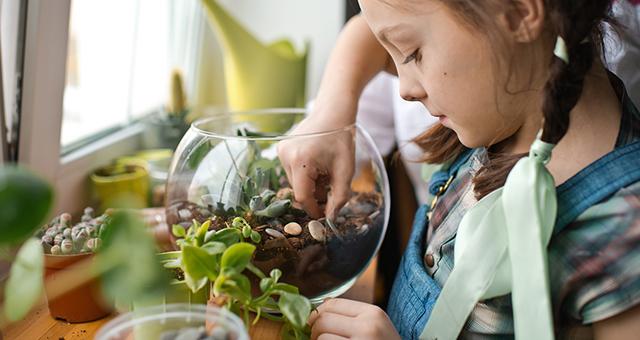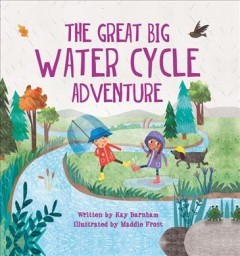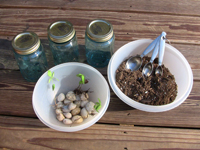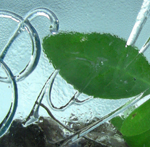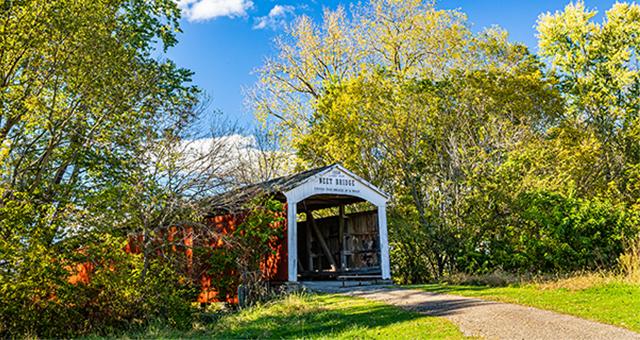The water on the earth is in constant motion. Water falls to the earth as rain and then evaporates back up into the air forming clouds. Evaporation is the process that changes liquid (like water) to gas (water vapor in the air). Water vapor in the air forms tiny droplets. When there are a bunch of these droplets clouds form. When a bunch of the droplets stick together raindrops form and fall back to earth again. After the rain falls, some of it soaks into the earth, and some of it evaporates into the air again. This cycle is call the hydrologic or water cycle. You can build construct a DIY terrarium and observe the water cycle in it.
Make a DIY Terrarium
To see how the hydrologic cycle works you can make your own miniature model of the earth in a terrarium. A terrarium is a little garden inside a clear, sealed plastic or glass container. A canning jar is a common glass container with a lid that might be easy to find at home. You can probably find the other things you need for your terrarium in your own backyard: small stones go in the bottom of the container, dirt, and a small plant or two. Look in shady areas for moss, it grows really well in a terrarium! You can also plant seeds and watch them grow.
Here are two videos that will help you. One explains how the water cycle works and the other will take you through step-by-step directions for building your own DIY terrarium.
What You Need
- a Clear Plastic or Glass Container With a Lid
- Stones
- Soil
- Plants
- Water
- Little Toys for Decoration (optional)
Instructions
After planting, add enough water just to moisten the soil. You don’t want to flood your garden. You don’t want standing water in the bottom of the container. When you poor water into your terrarium you are starting the water cycle. Eventually, it will “rain” in the little glass world you have made! When you set your terrarium in the sun the water inside the terrarium will heat up and turn into water vapor in the air. This is called evaporation. When the water cools back down, it turns back into a liquid. You will see condensation – water droplets – sticking to the lid of your terrarium. If the drops get large enough, they will roll down the sides of the container or fall from the lid – rain!
The close-up on the left shows the condensation that began to form on the inside of the jar after only 1 hour sitting in the sun. If there is too much water just open the lid and let some of the water evaporate into the air outside the container. If your plants look wilted or dry, try adding a little more water. It might take some trial and error to get the amount of water needed just right.
Science Experiment Idea
Make three identical terrariums. You have to use the same kind of container, the same amount of soil & the same plants. Make your variable (the thing you are going to test) the amount of water you put into the terrariums. Measure a different amount of water into each terrarium. Close the lids and watch the terrariums over several days to see which amount of water made the best environment for your plants. A terrarium with too little water will have dry plants. A terrarium with too much water will have plants with yellow leaves and maybe even mold growing on the soil!
Websites, Activities & Printables
- PBS Kids: Plant a Terrarium
- NASA ClimateKids: What is the Water Cycle?
- NASA ClimateKids: Make a Terrarium Mini Garden
- USGS: Water Cycle for Kids
- USGS: Evaporation and the Water Cycle
- National Geographic Kids: The Water Cycle
- American Museum of Natural History: Create a Coral Reef

You can also ask a math and science expert for homework help by calling the Ask Rose Homework Hotline. They provide FREE math and science homework help to Indiana students in grades 6-12.
e-Books & Audiobooks
Use your indyPL Library Card to check out books about plants at any of our locations, or check out plant e-books and audiobooks from OverDrive Kids right to your device! If you have never used OverDrive before, you can learn how to use it for both e-books and audiobooks.
Need more help? Ask a Library staff member at any of our locations or call, text or email Ask-a-Librarian. Additionally, the Tinker Station helpline at (317) 275-4500 is also available. It is staffed by device experts who can answer questions about how to read, watch and listen on a PC, tablet or phone.
Little Indoor Gardens for Kids – Terrariums & the Hydrologic Cycle
To see how the hydrologic (water) cycle works you can make a miniature model of the earth in a terrarium. A terrarium is a little garden inside a clear, sealed plastic or glass container. After making one, you can watch how water evaporates, condenses and rains. Here are some books to help you learn about the hydrologic cycle and put together a terrarium of your own.
